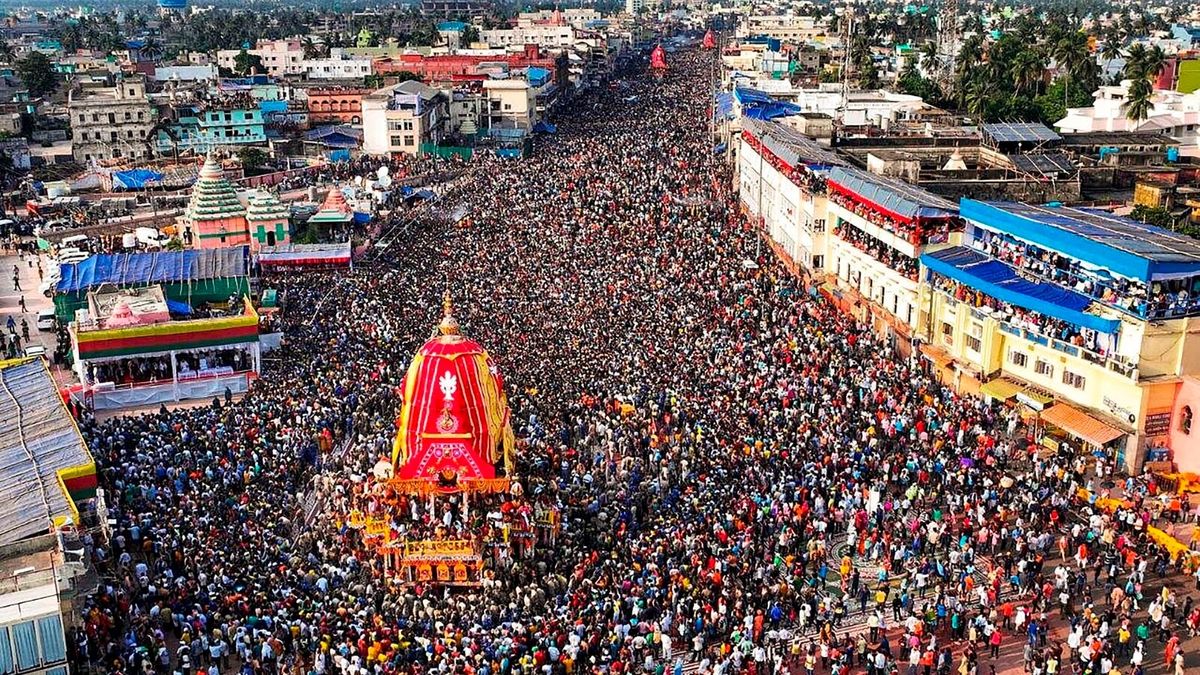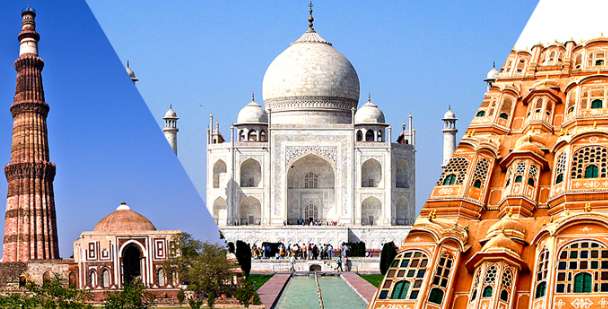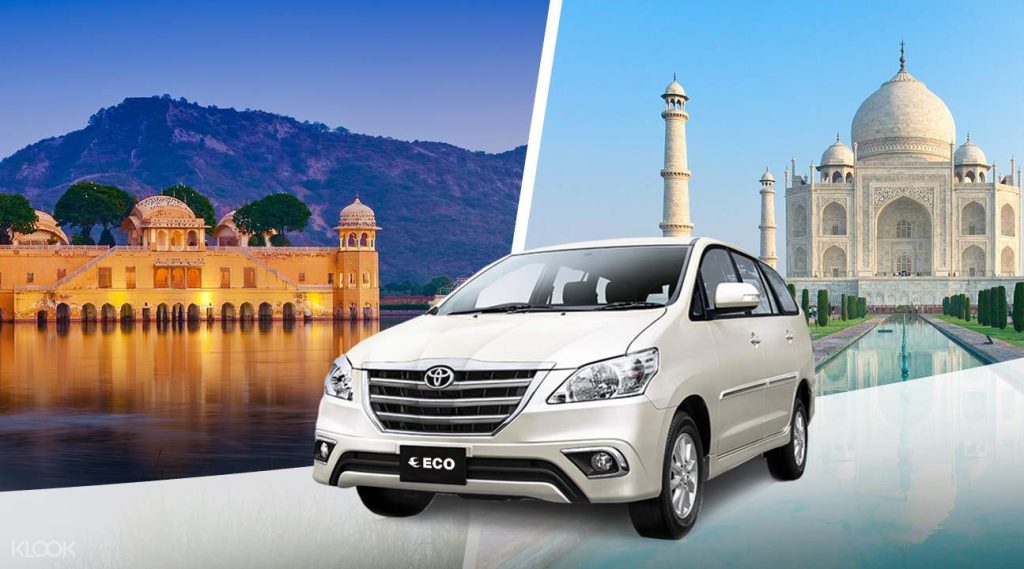
Every summer, the coastal town of Puri in Odisha awakens to a spiritual fever that echoes across its streets and resonates in the hearts of millions. This phenomenon, known as “Ratha Yatra” or “The Festival of Chariots”, is far more than a religious festival; it is a communal surge of devotion and humanity. At the first dawn of the procession day, the ancient Jagannath Temple opens its gates to a tide of worshippers who have journeyed from tiny villages, crowded cityscapes, far‑off towns, and even distant countries. They come in colourful dresses, covered with sandalwood, offering flowers, sweets, and their longing for peace and relief. The air becomes dense with the sound of conch shells (the sound of shankha), the rhythmic thunder of mridangas, and the resonant chant of “Jai Jagannath!”, a call that invites the divine to come down to earth.
For many, the moment they catch sight of the three gigantic wooden chariots Nandighosha, Taladhwaja, and Darpadalana, parked before the temple, is unforgettable. These are not just chariots; they are symbols of divine accessibility, reminders that the gods choose to step into the material world. When the chariot wheels begin to move and devotees wrap their hands around the sacred ropes, pulling with all their strength and faith, there is an almost electric transformation in the city. Barriers dissolve: caste, creed, nationality all become meaningless in that swell of shared devotion. The festival serves as an example of an ideal society, united, humble, and driven by a shared belief.
In 2025, as Ratha Yatra approaches, a new layer emerges in this age-old ritual: a growing awareness that celebrating with environmental care can enrich the experience and honour tradition in a meaningful way. ECO Mobility, with its commitment to sustainable transport and green pilgrimage, joins this festival not just as a service provider but as a partner in creating a festival experience that cares for both pilgrims and the planet. As you prepare to attend Ratha Yatra this June, this guide will walk you through everything you need.
When is Ratha Yatra in 2025? Dates and Key Rituals to Witness:
The main “Ratha Yatra” festival is on Friday, 27th June 2025. Before the procession, several other rituals follow, leading to the final day of the worship.
Snana Yatra- The Sacred Ceremonial Bath (June 11, 2025):
On the full moon day of Jyestha, June 11, 2025, the festival formally begins with Snana Yatra, a ceremony that sets the spiritual atmosphere for the entire Ratha Yatra. As dawn breaks over Puri, the temple ponds shine and priests gather wooden ladders, pots, and a herbal mixture. One by one, 108 brass pots are filled with holy water drawn from sacred rivers, infused with sandalwood paste, tulsi, and fragrant oils. Each pour is deliberate, delivered with respect and precision. The bath transforms not only the wooden idols of Lord Jagannath, Lord Balabhadra, and Devi Subhadra, but also the atmosphere around them, infusing the air with the scent of devotion.
Once the deities are bathed, they are believed to experience a metaphoric “fever” caused by the herbs and bath. The temple doors close, signalling the beginning of their withdrawal from the public gaze. Snana Yatra is more than a cleansing act; it is a symbolic healing journey, preparing the souls of the gods (and the devotees) for the transformation ahead.
Anavasara- The Period of Divine Seclusion (June 12-26, 2025):
Following the grandeur of Snana Yatra, Anavasara arrives, a fourteen‑day period during which the sacred idols are hidden from devotees. The temple closes its inner sanctum, and the gods enter a phase of rest and recuperation. Devotees are invited to worship the finely crafted Pata Chitra, painted wooden icons that depict Jagannath, Balabhadra, and Subhadra in intimate detail. These paintings are worshipped with the same intensity and tenderness as the idols themselves.
During this time, pilgrims often visit the temple precincts daily, bringing flowers, sweets, and paan for the representations. Each offering is made with the belief that it reaches the deities in their private recuperation. The hum of pilgrim activity continues outside, their minds resting in the belief that the gods’ restorative phase is part of a sacred cycle, one that mirrors human life in its rhythm of rest and renewal.
Netrotsava- The Reawakening of Divine Vision (June 26, 2025):
As the final day of seclusion approaches, a notable sense of joy grips the temple and the city. Netrotsava, the ritual painting of the deities’ eyes, marks their return to public view. At dawn on June 26, priests begin the meticulous task of painting and anointing the eyes, symbolically restoring divine sight. Onlookers hold their breath as the final stroke is laid; the newly opened eyes blink back at assembled devotees.
This moment is electric, stirring deep emotion among the faithful. Sobs of joy echo through the shrine, and the ocean of small lamps that fills the courtyard with light. Netrotsava functions as a symbolic rebirth. The idols, once hidden, now return to participate in the grand spectacle of Ratha Yatra, embraced anew by their devotees in a moment of profound reunion.
Ratha Yatra- The Story Behind The Chariot Procession (June 27, 2025):
At dawn on Friday, June 27, all elements converge for the sacred procession. Three majestic chariots, “Nandighosha for Jagannath”, “Taladhwaja for Balabhadra”, and “Darpadalana for Subhadra”, stand ready, elaborately decorated with vivid red, yellow, and blue textiles. Idols are carefully placed atop each wooden marvel, and priests chant age-old mantras to invoke divine presence.
When the first rope is grasped, an almost electric hum surges through the vast crowd. Pilgrims around the chariots begin to chant “Jai Jagannath!” in unison, and slowly the wheels of Nandighosha creak into motion. Then, one by one, the other two chariots begin to roll. As chants, conches, and drum beats intensify, the chariots inch forward along the three-kilometre path to Gundicha Temple.
Pulling the rope is considered an act of moksha, an effort that washes past karma and affirms one’s faith. For many pilgrims, simply touching the rope is a moment of liberation, the embodiment of communal devotion, physical exertion, and spiritual surrender.
Hera Panchami- Divine Reunion Through Playful Drama (July 1, 2025):
As the gods settle into Gundicha Temple, the narrative shifts to one of myth and emotion. On July 1, Hera Panchami unfolds a playful yet profound story involving Goddess Lakshmi, Lord Jagannath’s consort. It is believed that Lakshmi begins a journey from the main temple to Gundicha Temple, only to discover her husband absent.
The drama deepens when she discovers evidence of Jagannath’s universal journey and expresses her affection-tinged disapproval by symbolically striking Jagannath’s chariot with black dye, an act described with theatrical gestures by temple priests. Hera Panchami embodies divine love, jealousy, and reconciliation, a different way within cosmic storytelling. For pilgrims, it brings the gods down from their pedestal, revealing the intimacy and depth of divine relationships.
Bahuda Yatra- The Return Journey of the Divine Trio (July 5, 2025):
The emotional arc of Ratha Yatra completes its cycle days later, on July 5, with Bahuda Yatra, the return procession. The chariots are lovingly prepared once more, and the deities, now settled in Gundicha Temple, are invited to return to Jagannath Temple. Pilgrims gather at dawn, eager to pull the chariots homeward.
This journey back is suffused with gratitude, relief, and spiritual fulfilment. Chants reverberate with softer sincerity, marking a closure that is both celebratory and introspective. The return reveals a heightened intimacy between the gods and their devotees, who feel they have escorted the divine children home after a sacred outreach. The chariots re-enter the temple courtyard to songs, conches, and a sense of holy completeness.
Suna Besha- The Golden Adornment in Final Splendour (July 6, 2025):
The culmination of Ratha Yatra occurs the next day, July 6, in the breathtaking ceremony of Suna Besha. The deities emerge resplendent, adorned with golden jewellery, crowns, necklaces, armlets, and garlands. Sunlight catches the ornaments, making them gleam like beacons of holy light.
The spiritual atmosphere is rich with awe and reverence. Pilgrims bow low, some weep in wonder, and many capture the moment with heartfelt stillness rather than photographs. Suna Besha is the festival’s peak, a final, dazzling expression of devotion, marking a gloriously radiant end to a journey that began with a cleansed bath and ended with pure light.
These rituals, Snana Yatra, Anavasara, Netrotsava, Ratha Yatra, Hera Panchami, Bahuda Yatra, and Suna Besha, form a living mandala. They invite pilgrims to walk through purification, seclusion, reunion, public spectacle, divine reconciliation, return, and transformative radiance. Together, they craft an emotional arc that mirrors life’s deepest journeys, bathing in vulnerability, withdrawing for healing, returning with renewed vision, and culminating in a dazzling inner splendour.
How to plan a trip to Puri for Rath Yatra?
Ratha Yatra is more than a religious celebration; it’s a profound spiritual immersion that calls for the full presence of mind, body, and soul. This isn’t a festival where you passively observe from the sidelines. Instead, every individual who steps into the city of Puri becomes part of a living ritual, a moving river of faith. The energy is raw, the emotions are deep, and the physical demands are very real. This guide offers a holistic understanding of what it means to prepare for such a transformative journey, helping pilgrims make the most of their experience in every way possible.
Embrace the Intensity of the Experience:
Ratha Yatra is not your typical vacation or cultural event. It is a high-intensity, deeply spiritual experience where thousands of years of history come alive in front of your eyes. The moment you step onto the streets of Puri, you are absorbed into a divine atmosphere that demands openness, humility, and resilience. Pilgrims do not come to relax; they come to participate in an event that transforms the soul. As you stand shoulder to shoulder with thousands of other devotees, all chanting the names of the Lord, you become one thread in a vast tapestry of faith. Expect spontaneity and spiritual ecstasy, and prepare to surrender your expectations and control. The festival will unfold around you, and your only task is to stay present, to witness, and to serve.
The Street Life of Puri During Ratha Yatra:
During Ratha Yatra, the streets of Puri transform into vibrant corridors of devotion. Vendors line the lanes with garlands of fresh marigolds, incense sticks, and traditional sweets. Brass bells jingle from make-shift stalls while conch shells sound from distant corners. Pilgrims rest by the roadside, sharing stories, sipping coconut water, or engaging in spontaneous kirtans. Amid this chaos, there is harmony, strangers become friends, spiritual seekers share food, and a single chant can bind thousands into one rhythmic pulse. The streets become vibrant with life, yet there’s a sacred silence beneath the noise, a silence filled with presence and prayer.
Coping with Odisha’s June Weather:
The weather in Odisha during June can be challenging. The mornings are typically dry and hot, while the afternoons bring heavy humidity or sudden monsoon showers. The ground can go from dusty to muddy in minutes, making it physically taxing. Staying hydrated becomes essential; carry a reusable water bottle and sip constantly. Wear loose, light-coloured cotton clothing that allows your body to breathe. A small towel or umbrella offers a portable shield against both sun and rain. And remember, this discomfort is part of the offering; it humbles the body and prepares the mind for spiritual focus.
Experiencing the Festival’s Emotional Power:
Emotion runs deep during Ratha Yatra. You’ll see elderly devotees gripping the sacred rope with trembling hands, refusing to let go despite their age. Young children gaze in awe at the towering chariots, their eyes reflecting wonder. Families push through the dense crowds so everyone, even the smallest among them, gets to see the Lord. And international visitors, often unfamiliar with the rituals, are overwhelmed by the sensory rush, the smell of camphor and sandalwood, the drums and chants that rise like waves, the sea of humanity moving in unison. These moments are raw and real. They inspire reflection, compassion, and sometimes even tears. Everyone is equal here, pulled together by a divine force larger than life.
Physical and Mental Readiness:
This journey requires stamina, not just physical, but mental and emotional. Expect to walk for miles, often under a blazing sun or through monsoon rain. Standing for long hours or sitting on hard temple grounds is the norm. Basic amenities are often stretched due to the volume of pilgrims. There’s little room for personal comfort. But what you receive in return is spiritual nourishment and communal strength. Prepare by gradually increasing your physical activity before you arrive; daily walks, light yoga, and deep breathing help. Train your mind to accept the unpredictable. Stay grounded in the purpose of your pilgrimage, and let every discomfort become a form of worship.
Accommodation Options in and Around Puri:
Where you stay plays a key role in your Yatra experience. Proximity to the temple and chariot route means easier access but higher noise and crowd levels. Bookings begin filling up as early as March. By April or May, finding space near the main temple becomes difficult. Many pilgrims opt for dharmashalas, simple, charity-run hostels with minimal facilities but a deep spiritual ambience. Some prefer homestays where they can experience Oriya hospitality and traditional food. For those looking for a quieter, conscious retreat, guesthouses offer rooms made with sustainable materials, solar heating, and peaceful gardens. These places provide rest and reflection, balancing the high energy outside with calm within.
What to Pack for a Smoother Yatra Experience?
Packing is part of preparation. Bring a refillable water bottle, a power bank for your phone, first-aid essentials, and a small backpack to carry them. Carry energy snacks like dry fruits, glucose, or packaged sweets. Wear breathable cotton clothes and sturdy sandals suitable for both heat and rain. An umbrella or a cap can offer some relief from the harsh sun. Avoid carrying too many valuables. Keep your documents and identity proof safe and accessible.
How to Reach Puri for Ratha Yatra?
There are several ways to reach Puri for Ratha Yatra. There is good public transportation to reach the pilgrimage site.
By Road: Puri is well-connected by road to major cities in Odisha and neighbouring states. State-run and private buses regularly operate from Bhubaneswar, Cuttack, and Kolkata. Travellers can also hire taxis, rent cars or opt for a bus for a convenient and comfortable road journey.
By Train: Puri Railway Station is a central terminus on the East Coast line, linking to cities like Delhi, Kolkata, Chennai, and Mumbai. Special trains are often added during Ratha Yatra due to high demand. Booking tickets well in advance is strongly recommended, especially during festival season.
By Flight: The nearest airport is Biju Patnaik International Airport in Bhubaneswar, about 60 km from Puri. Daily flights connect it to major Indian cities.
Local Food and Culture: Feasts for Body and Soul
Within every throb of the procession, every echo of “Jai Jagannath,” lies the pulse of Odisha’s culinary heritage. Food becomes a flowing, essential part of the ritual. Early mornings bring the aroma of freshly cooked khichdi, the festival’s signature offering. Garlands of local bananas and strings of dry prasad sweets move through the crowd like a pilgrimage in transit. Street cooks pour hot lentil soups into clay kulhads, reminding weary pilgrims that Divine Mother sustains even in small graces.
Near the chariot route, small stalls spring up overnight. Plastic jars brimming with chhena puris or malpua. Vendors flip soft, deep-fried bread stuffed with lightly spiced potatoes. The sweet cloy of kheer, made with sticky rice, milk, and cardamom on request. It’s traditional to sample all of them, not just as sustenance, but as ritual communion. Every spoonful, every shared cup becomes an offering, a gesture of unity with fellow pilgrims.
At dusk, the air thickens with more devotional richness. Folk singers form impromptu circles and begin bhajan sessions. Their voices slow and rise with the tempo of drums as passersby drop in for fifteen minutes or hours. These bhajan clusters are not orchestrated; they form out of devotion and dissolve just as spontaneously when the next wave of procession advances. Sometimes, a group of young temple students takes over. They play bamboo flutes and tiny cymbals, or recite verses about the glories of Jagannath and his compassion. Pilgrims, moved by the cumulative spiritual energy, begin to sway, chant, and cry. Cultural boundaries drop away.
After sunset, small roadside stalls offer modest meals: a bowl of dalma (lentils and vegetables cooked with light spices), a plate of aloo bhaapa, or tender coconut water fresh from husked shells. Several old women hand out khaja, a layered pastry soaked in sweet syrup. Eating in the open under the night sky, sharing with neighbours, exchanging wrappers or spoons, it becomes more than food. It becomes care. It sustains bodies, but also spirits.
As Ratha Yatra 2025 draws to a close with Suna Besha’s golden luminescence and chariot wheels giving way to the temple courtyard, pilgrims find themselves standing at a crossroads. The gods have returned to their sanctum; the city slowly empties of chanting crowds. But something remains indelible: the memory of pulling the chariot, the sound of communal chant, the taste of khichdi in the rain, the glow of lamps held aloft in the darkness.
In Ratha Yatra 2025, we encountered one another, touched history, honoured tradition, and reminded ourselves that we belong to Earth, to each other, and to timeless faith. May this festival’s legacy guide your hearts long after the chariots have departed.


